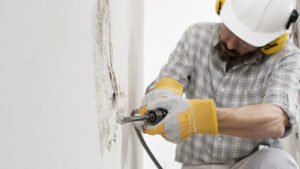Residential roofers handle a wide variety of roof-related tasks. From roofing installation and repairs to gutters, soffits and fascia, they take care of everything that protects your home from the elements.

Working with a top-rated residential roofer is one of the best investments you can make for your property. They have the specialized tools, skills and experience to work safely with all types of roofing materials. Contact Fresno Roofing Experts for professional assistance.
A residential roof is a vital component of your home, and keeping it in good condition is important to maintaining the structure. It protects your house from weather, and it prevents water penetration and other damage. If you’re experiencing problems with your roof, a professional roofing contractor can help. They’ll inspect the damage and provide a repair estimate. They’ll also advise you on the best roofing materials for your house.
A qualified and experienced roofing contractor can offer a wide range of services, including roof installation, repairs, and replacements. They’ll use high-quality roofing materials and ensure that the job is done properly. They’ll make sure your roof is properly insulated and waterproofed, which will prolong its lifespan. Additionally, they’ll recommend ways to keep your roof safe from leaks and other problems.
Some roofers specialize in different types of roofing. For example, some install green roofs, which are designed to support plant growth and contribute to environmental sustainability. Others have expertise in working around large roof accessories, such as chimneys and smokestacks.
The path to becoming a residential roofer is long and challenging. It involves an apprenticeship and multiple exams to gain the proper skills. Some also go on to get a general contractors license. Those who choose to work on commercial roofs may need additional training and experience with specific roofing systems, such as EPDM, PVC, and metal.
Another type of roofing specialist is the roof repair contractor, who can diagnose and resolve problems with a variety of roofing materials. These problems include leaks, blow offs, and structural damage. Roof repair contractors can also handle problems with gutters and soffit ventilation, which can increase the longevity of your roofing system.
Roofing contractors New York are known for their perfect client fulfillment and ensuring the safety of their staff on site. They always strive to complete projects on time and within budget. They also ensure that all workers wear the appropriate personal protective equipment and follow industry standards. They also have a dedicated support person who is onsite all day and can answer questions and interact with the crew for you.
Warranty
Most roofing installation or replacement projects are covered, at least partially, by manufacturers’ warranties. These warranties guarantee the materials against defects and failure for a specific period of time, on average between twenty and fifty years. Typically, the longer warranty periods are reserved for pricier, high-end products, such as slate or metal roofs. Manufacturer warranties often have limitations and exclusions, however, that limit their liability and help reduce costs. For example, most will not cover problems caused by severe weather damage unless the damage is listed as an exception.
In addition to manufacturer warranties, some roofers also offer their own workmanship warranties. These warranties promise to cover any issues with the roof that occur as a result of incorrect installation techniques or worker error for a specified time. There can be a great deal of variation between the warranties offered by different contractors, so it’s important to carefully read each one before making a decision. In general, look for a warranty that offers the most protection in the least amount of time, as well as a transferability option should you decide to sell your home during the coverage period.
Some roofers will also provide system warranties, which combine product and installation warranties into a single package. These warranties are generally only available when the roof is installed with components from the same manufacturer, as they will have been designed to work together. System warranties are a great option for homeowners who want the peace of mind that comes with knowing that both their roof and their investment are protected.
It’s important to keep in mind that, regardless of what type of warranty you have on your roof, it may be voided if the proper maintenance isn’t performed. That’s why it’s always a good idea to use a roofer who will provide routine roof inspections and cleaning services. In addition, be careful when choosing a roofer to perform any maintenance on your roof, as using a non-certified contractor could also void your warranty.
Safety
Roofing is a dangerous job, so it’s important to take the proper precautions. Residential roofers have the skills and tools to work safely on your home’s roof, and they’ll make sure everything is set up correctly. They also know how to spot any problems with the structure of your house or the materials you’re using, and they can fix them before they become larger issues.
Despite their best efforts, accidents can happen, and some of those accidents involve workers falling from heights. Approximately 50 roofers die each year from work-related incidents, and 34% of those deaths happen during truss installation.
Proper safety measures can help prevent these types of tragedies, but sometimes residential roofers might view these precautions as a nuisance rather than an essential component of their jobs. For example, they might feel that safety harnesses and establishing guardrails add an unnecessary layer of complexity to their already complex tasks. They might also believe that following the guidelines of safety protocols will slow them down or cause them to miss deadlines and project goals.
Unfortunately, this perception can lead to a lack of consistent enforcement of these standards by employers. This can create a loophole in the workplace where employees don’t understand the importance of following safety protocols.
To combat this issue, employers can provide workers with access to resources that will help them identify potential hazards on a job site before the shift begins. These resources might include ladder safety checklists, a roof safety mobile application, infographics and tipsheets, toolbox talks, and training courses.
The hazard identification process should include all employees, from the general manager to the roofers themselves. Using these tools will ensure that every worker is aware of the risks associated with working on rooftops and that they’re able to take appropriate steps to minimize these risks.
It’s also important for workers to use the right safety gear when they’re on the roof, and that includes wearing non-slip shoes, a hard hat, and gloves. Additionally, they should always be using a ladder that’s in good condition and blocking off the area surrounding their work area to keep people, pets, and children out of harm’s way. They should also block off power lines and cover them with high-visibility tarps to avoid tripping.
Time
It takes time to complete a roof installation or replacement. Residential roofers can give homeowners a rough estimate of how long it will take, but the actual time frame depends on a few different factors. For example, the size of your roof and the type of roofing materials that you choose will affect how long it takes to install a new roof. Also, if you have children, it may be best for them to stay with grandparents during the roofing process, because there will likely be debris everywhere.








